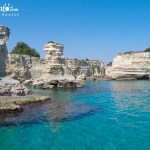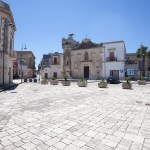
Traces of Nordic architecture can also be found unexpectedly in the deep South of Salento: it is the Apulian Romanesque, an artistic style that developed between the 11th century and the first half of the 13th century. Below, let’s take a short tour of the examples of excellence: the Cathedral of Otranto, the Basilica of Santa Caterina d’Alessandria in Galatina and the Abbey of Santa Maria in Cerrate.
The typical characters of Northern European art (France, Germany, Normandy) reworked with elements of Byzantine and Arab art give rise to an original and unprecedented result which is the so-called Apulian Romanesque. The Nordic, and in particular Norman, imprint in these areas is due to the frequentation of the Apulian ports by pilgrims headed to the Holy Land and which were also the starting point for many participants in the First Crusade in 1090.
The cathedral of Otranto
An important example of Apulian Romanesque is the cathedral of Santa Maria Annunziata, built on the remains of a Roman domus, a Messapian village and an early Christian temple. It was founded in 1068 by the Norman bishop Guglielmo and consecrated to worship in 1088. Inside it preserves an important floor mosaic made between 1163 and 1166 by the Basilian monk Pantaleone.

In August 1480, the cathedral was the scene of a terrible carnage: the Turks stormed the city after a few days of siege and entered the church exterminating the clergy and civilians who had taken refuge there, whose remains are still preserved in the crypt. It was transformed into a mosque and all the frescoes dating back to the 13th century were destroyed.
The abbey of Santa Maria di Cerrate

Located on the Squinzano-Casalabate provincial road, it is one of the most significant examples of Apulian Romanesque. According to legend, the abbey was founded at the end of the 12th century by Tancredi d’Altavilla, count of Lecce, when in this place, during a hunting trip, the Madonna appeared in Tancredi between the horns of a deer, hence the toponym Cerrate or Cervate.

The locality was an important religious and cultural center until the sixteenth century and subsequently transformed into a farm. In 1711 the abbey was sacked by Turkish pirates and fell into a state of neglect, which continued until the 1965 restoration by the Province of Lecce. The complex remained the property of the local authority until 2012, the year in which it passed to the Fondo Ambiente Italiano.
The Basilica of Santa Caterina d’Alessandria in Galatina
It is one of the most famous monuments of Apulian Romanesque and Gothic art and was built between 1369 and 1391, by the will of Raimondello Orsini del Balzo. The latter, in one of his numerous journeys, returning from the Crusades, went as far as the summit of Mount Sinai to pay homage to the body of Saint Catherine; according to legend, when she left, he kissed the hand of her Saint, tearing her finger with his teeth. Back in Italy he took the relic with him which, set in a silver reliquary, is still kept in the church treasury. The building, on Raimondello’s death in 1405, will be completed by his wife, Princess Maria d’Enghien, and then by his son, Giovanni Antonio Orsini Del Balzo.


The building was built on a pre-existing Byzantine church of the Greek rite dating back to the IX-X century whose traces are clearly visible in the outer wall of the right aisle in which the apse was incorporated, perhaps to save building material. The pictorial decoration is of great artistic importance: the interior, in fact, was completely frescoed towards the end of the fourteenth century by local workers, covering some parts of the oldest fragments.
If you don’t know where to sleep in Salento, here you will find some useful advice.
holiday houses -> www.casesalento.com
Holiday luxury villas -> www.villesalento.it
email -> info@villesalento.it
Mobile Phones -> (+39) 366/2604050 – (+39) 392/0202233












Leave a comment